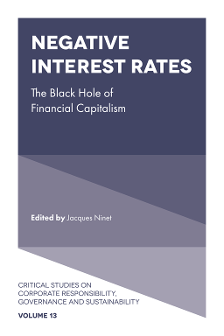
Financial Capitalism: From the Neoliberal Revolution to the Multifaceted Crisis of the Twenty-first Century
ISBN: 978-1-83982-377-0, eISBN: 978-1-83982-376-3
ISSN: 2043-9059
Publication date: 26 November 2020
Citation
Ninet, J. (2020), "Financial Capitalism: From the Neoliberal Revolution to the Multifaceted Crisis of the Twenty-first Century", Negative Interest Rates (Critical Studies on Corporate Responsibility, Governance and Sustainability, Vol. 13), Emerald Publishing Limited, Leeds, pp. 5-6. https://doi.org/10.1108/S2043-905920200000013002
Publisher
:Emerald Publishing Limited
Copyright © 2021 Emerald Publishing Limited.
Nothing ever comes to pass without there being a cause or at least a reason determining it that is, something to give an a priori reason why it is existent rather than non-existent, and in this wise rather than in any other.
(Leibniz, 1710)
Introduction
It's hard to get students born in the 1990s to imagine what the world was like when this old professor was their age. It was a world where people feared that the Soviet bogeyman could ultimately overtake its nemesis, America; where the price of oil tripled in three weeks, and gasoline at the pump soared; a world of double-digit inflation, mortgage rates over 15%, ex-post index linked wage adjustments, etc.
That world vanished in less than 10 years, making way for the globalization of the economy, the opening up of new countries to the market economy, and more deregulated financial standards.
How did such a radical shift occur so rapidly? And what were its underlying causes?
Disinflation and its companion, falling interest rates, created the conditions for a stock market golden age (market capitalization in the United States increased 14-fold in less than two decades). Yet the economic and fiscal record of this revival of capitalism is still far from conclusive. Increasingly brutal crises took place in close succession and the disappearance of the economic cycle, the Holy Grail of deregulation proponents, sadly foundered on the shoals of the worst recession of the postwar era.
Meanwhile, global growth continued to slow over 30 years. Middle classes of industrialized countries, which reigned supreme over the glorious years following the World War II, and powered the engine of the Fordist Model, have been destroyed. Meanwhile those of the emerging countries, though admittedly rising very rapidly, were not enough to overcome economic insecurity or persistence of extreme poverty (according to the World Bank, nearly 800 million people still live on less than USD 1.90 per day). Such subdued performance has not prevented the attachment of these middles classes to the principle of individual accumulation savings thanks to which they have become staunch allies of the holders of capital.
- Prelims
- Introduction
- Part 1 Financial Capitalism: From the Neoliberal Revolution to the Multifaceted Crisis of the Twenty-first Century
- The Great Turn
- Neoliberalism and the Revenge of Rentier Capitalists
- The Underpinnings of Hyper-Financialization
- The Poor Economic and Financial Record of Thirty-five Years of Neoliberalism
- Part 2 Anatomy of a Crisis
- The Single Crisis of the Asset-based Economy
- A Foreseeable but Not Foreseen Crisis
- Deficit and Debt Trap
- A Useless Crisis?
- Part 3 In the Hands of Central Banks
- Central Bank: A Standard Reading
- Some Facts about the Monetary Economy … To Better Understand the True Role of Central Banks
- The Short History of Central Banks in the Long History of Money
- Theoretical Foundations of Central Banking: From Monetarism to Dynamic Stochastic General Equilibrium (DSGE) Models
- Does Independence Guarantee Infallibility?
- Are Central Bankers Truly Independent?
- An Astonishing Confession
- Part 4 Who Will Save the Central Banks?
- The Black Hole
- Economic and Financial Consequences of NIRP and ZIRP
- TINA (There is No Alternative)?
- Central Banks: At the Core of the Next Confidence Crisis
- Conclusion
- Afterword
- Appendices
- References
- Index of Names